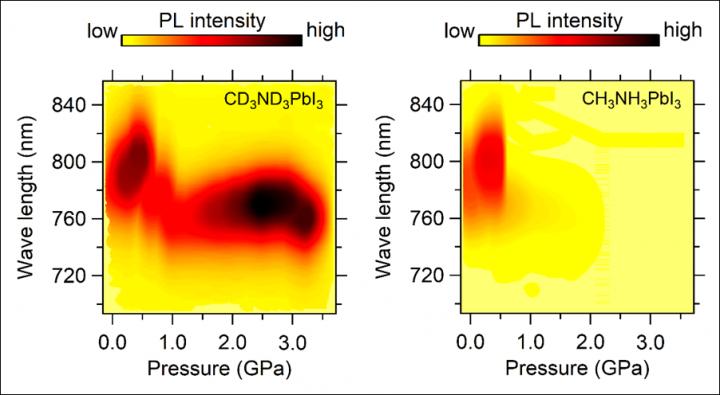
Credit: Gang Liu
Organic-inorganic hybrid lead iodide perovskites are universally recognized as very promising photovoltaic (PV) materials. While outstanding PV performance is continuously reported, manipulating these hybrid perovskites for extraordinary optoelectronic properties with a greater intrinsic structural stability becomes a growing attention. The soft nature of organic-inorganic halide perovskites renders their lattice particularly tunable to external stimuli such as pressure, undoubtedly offering an effective way to modify their structure for extraordinary optoelectronic properties. However, these soft materials meanwhile feature a general characteristic that even a very mild pressure will lead to detrimental lattice distortion and weaken the critical light-matter interaction, thereby triggering the performance degradation.
Herein, an international research team led by scientists from Center for high pressure science and technology advanced research (HPSTAR) reported a comprehensive high-pressure isotope research on hybrid perovskites. To their surprise, it is observed that the pressure-driven lattice disorder can be significantly suppressed via hydrogen isotope effect, which is crucial for better optical and mechanical properties previously unattainable. By in situ neutron/synchrotron-based analysis and optical characterizations, a remarkable photoluminescence (PL) enhancement by threefold is convinced in deuterated CD3ND3PbI3, which also shows much greater structural robustness with retainable PL after high peak-pressure compression-decompression cycle.
The researchers also proposed an atomic level understanding of the strong correlation among the organic sublattice and lead iodide octahedral framework and structural photonics, where the less dynamic CD3ND3+ cations are vital to maintain the long-range crystalline order through steric and Coulombic interactions. In addition, the result of device-related investigations shows CD3ND3PbI3-based solar cell has comparable photovoltaic performance as CH3NH3PbI3-based device but exhibits considerably slower degradation behavior, thus representing a paradigm by suggesting isotope-functionalized perovskite materials for better materials-by-design and more stable photovoltaic application.
###
More Information: Kong, L., Gong, J., Hu, Q., Capitani, F., Celeste, A., Hattori, T., Sano?Furukawa, A., Li, N., Yang, W., Liu, G., Mao, H.?k., Suppressed Lattice Disorder for Large Emission Enhancement and Structural Robustness in Hybrid Lead Iodide Perovskite Discovered by High-Pressure Isotope Effect. Adv. Funct. Mater. 2020, 2009131.
https:/
Media Contact
Haini Dong
[email protected]
Original Source
http://hpstar.
Related Journal Article
http://dx.




